 July 23, 2020 John E. Ross, KD8IDJ, Editor
| ||||||
ARRL Members to Lead New 30-Minute Amateur Radio Webinar Series ARRL is launching a new webinar series to help introduce more members to the variety of activities and opportunities that radio amateurs enjoy. The ARRL Learning Network will offer live presentations by member-volunteers, for members. Like hamfest Presentations are 30 minutes each, making them easy to fit into a lunch break or as a short evening activity. A 15-minute question-and-answer period follows each presentation for those who can participate longer. The webinars will be hosted initially using GoToWebinar. Webinars will be recorded, and some presentations will be available for future viewing by members and ARRL-affiliated radio clubs as part of an ARRL Learning Network library. A running list of upcoming live presentations is available. The web page is the place to register to attend each webinar and requires members to log onto the ARRL website. Some presentations: Relay Stations and the Art of Traffic Handling Aaron Hulett, K8AMH, Section Traffic Manager for ARRL North Texas Section Tuesday, July 28, 2020, 10 AM PDT / 1 PM EDT (1700 UTC) Fun with Digital Signal Modes FT4 and FT8 Anthony Luscre, K8ZT Thursday, July 30, 2020, 12:30 PM PDT / 3:30 PM EDT (1930 UTC)
HF Wire Antennas George Cooley, NG7A, ARRL Life Member Thursday, August 6, 2020, 12:30 PM PDT / 3:30 PM EDT (1930 UTC) Introduction to Digital FM Modes Korey Chandler, Sr., WA5RR Tuesday, August 11, 2020, 5 PM PDT / 8 PM EDT (0000 UTC on Wednesday, August 12) Introduction to Computer Logging Steven Lott Smith, KG5VK Thursday, August 13, 2020, 12:30 PM PDT / 3:30 PM EDT (1930 UTC) Capture the Magic of 6 Meters Jim Wilson, K5ND Tuesday, August 18, 2020, 10 AM PDT / 1 PM EDT (1700 UTC) The Sport of Finding Hidden Transmitters on Foot Robert Frey, WA6EZV, ARRL Amateur Radio Direction Finding Committee Thursday, August 20, 2020, 12:30 PM PDT / 3:30 PM EDT (1930 UTC) The webinars continue a string of new ARRL benefits introduced in 2020 that has included On the Air magazine, expanded member access to all ARRL digital magazines, and the new On the Air and Eclectic Tech podcasts. "The ARRL Learning Network puts experienced member-volunteers at the forefront as a regular source of knowledge-sharing in amateur radio," ARRL Lifelong Learning Manager Kris Bickell, K1BIC, said. "We hope members participating in the ARRL Learning Network, including presenters, will find it particularly rewarding to share experiences and learning that will motivate more of our community toward lifelong journeys as radio amateurs." Members who would like to be considered for future ARRL Learning Network webinars should have experience in delivering presentations, including familiarity with online webinar technology, live video, and screen sharing. Prospective presenters may complete a Call for Speakers form. More than 12,000 Register Early for QSO Today Virtual Ham Expo More than 12,000 have registered to attend the first QSO Today Virtual Ham Expo, August 8 - 9, QSO Today host Eric Guth, 4Z1UG, said this week. "Since the Expo is a completely new experience for the ham radio community, it's great that so many people are excited and already registered," he said. "And with almost 3 weeks before the event, the number of registrants continues to increase." Attendance is free and there are early-bird prize incentives for registering by July 24. More than a typical web meeting, the Expo is built on a live virtual platform commonly used by Fortune 500 companies and major The Expo will offer four separate speaker tracks focusing on a range of topics. Speakers will also be able to provide related material, such as slides and white papers, that attendees can download. Every session will have a Q&A where attendees can submit questions in real time via chat. More than 30 booths will be open for attendees to visit, and exhibitors will have different options to engage with attendees. Exhibitor booths can provide downloadable content, such as videos, spec sheets, and manuals, and attendees can save content in a virtual briefcase to read later. Visitors will also be able to interact one-on-one with booth representatives, using a Skype-like system. "The experience of a virtual expo is not meant to replace in-person conventions," Guth said. "However, I strongly believe that virtual events in our community are here to stay. Given COVID-19 and its likely lasting impact on travel, especially given our demographic, this virtual expo enables the ham community to continue coming together to learn and engage." Guth said that younger hams who have grown up with the internet will feel comfortable with the Expo platform, "making it easier for them to participate and find their place in this remarkable hobby." Access to all speaker presentations and exhibitor booth content will remain on the Expo site for 30 days following the event. The QSO Today Virtual Ham Expo is an ARRL-sanctioned hamfest. Winlink Developers Use Arduino-Based Simulator to Evaluate Digital Modes Winlink development team members Rick Muething, KN6KB, and Tom Lafleur, KA6IQA, have evaluated various digital modes using the Teensy IONOS Simulator, which is based on the Arduino Teensy. A summary of the study by Thomas Whiteside, N5TW, indicates steady improvements in performance as software algorithms have evolved. "Simulator testing is important for creating and evaluating digital mode performance in a consistent, repeatable way that simply cannot be The simulator was used to evaluate digital modes supported on the Winlink system over statistically standardized channels of white Gaussian noise and multipath, with noise cases across a range of signal-to-noise values. For HF, both wideband (>2 kHz) modes (PACTOR 3, PACTOR 4, VARA 2300, ARDOP 2000, and WINMOR 1600) and 500 Hz modes (PACTOR 2, ARDOP 500, WINMOR 500, and an all-new VARA 500 mode) were tested. For VHF, AX.25-based packet, FX.25-based packet, and VARA FM were tested. Muething and Lafleur said that their Teensy IONOS Simulator offers a wide variety of HF multipath test cases. "In the real world, all signals experience some degree of multipath distortion, whether it is a local VHF/UHF signal arriving directly, as well as reflections off various objects, or an HF signal experiencing different effects from the ionosphere and/or arriving via different headings," the study notes. The simulator has four levels of multipath models: good conditions, moderate conditions, poor conditions, and disturbed conditions. The 19-page report includes signal-to-noise graphs of the various modes simulated under a variety of these scenarios. "No simulator can create all the band conditions, [interference from other stations], aurora, and other effects we can encounter, but these results should be a good comparison of performance over a wide range of conditions," the study's authors advised. Whiteside concluded, "I believe the Teensy IONOS Simulator is a useful tool for evaluating the various digital modes in use today and adds depth perception to over-the-air experience. For digital mode developers, this tool would be quite useful for evaluating new versions and experiments to supplement on-the-air testing. Specifically, I think the data presented here is a useful comparison of the various digital modes in use with the Winlink system today." ARRL Podcasts Schedule
The On the Air and Eclectic Tech podcasts are sponsored by Icom. Both podcasts are available on iTunes (iOS) and Stitcher (Android), as well as on Blubrry -- On the Air | Eclectic Tech. High School Marine Buoy Transmitter Now Active on 20-Meter WSPR Phil Karn, KA9Q; Randy Standke, KQ6RS, and members of the Mount Carmel High School Amateur Radio Club (MCHSARC) in San Diego have constructed and deployed an amateur radio marine buoy in the Pacific. The buoy, which transmits WSPR on 14.0956 MHz USB, has already been heard around the continental US, Brazil, Hawaii, Japan, Costa Rica, Australia, and South Africa. "Over the past year, Randy and I have mentored the MCHSARC in designing and constructing a simple marine buoy that was deployed from the RV Sally Ride [on July 16], about 700 kilometers off the coast of southern California," Karn said in a post on the AMSAT Bulletin The electronics are the 20-meter WSPR version of the WB8ELK "pico tracker" that has been flown on long-duration balloons. "We removed the solar panels and substituted 21 ordinary alkaline D cells, wired to supply 4.5 V," Karn explained. "We estimate battery lifetime will be 6 months." Karn said that the project made use of everyday hardware. The buoy -- essentially a spar buoy -- was constructed using a 5-foot section of 4-inch PVC pipe, with sufficient ballast in one end of the pipe to permit it to float vertically in the water. The top is closed using a sewer pressure test plug, which has a bolt in the center that acts as a convenient feed-through and antenna mounting point. The antenna is a stainless-steel CB whip with a matching network. "We use the sea as a counterpoise, but to avoid direct metal/sea water contact, we lined the inside of the pipe with copper tape to form a capacitive connection," Karn said. During initial flotation testing, the project team found that the ballasted pipe alone was remarkably stable in pitch, roll, sway, and surge, but oscillated a lot in heave -- i.e., up and down movement. "We tried to make this thing as rugged as we could," Karn recounted, offering his favorite saying to the students: "The sea always wins in the end, but we can delay that long enough to be useful." Deployment was to be from a NOAA vessel in April, but the trip was canceled due to the COVID-19 pandemic. Standke secured a trip on the RV Sally Ride, a research vessel operated by Scripps Institute of Oceanography. The first reception report was on July 16 at 12:52:30 UTC from grid square CL89eu, although the current carried the buoy east into CL89fu at 20:32:30 UTC. The buoy (KQ6RS-1) can be tracked on the APRS and WSPRnet sites. Karn said the project team is already planning its second buoy, which may include two-way links, satellite tracking, and sensors. The K7RA Solar Update Tad Cook, K7RA, Seattle, reports: Another Solar Cycle 25 sunspot (AR 2767) appeared this week, with a minimum non-zero sunspot number of 11 on July 21 - 22. The average daily sunspot number for the July 16 - 22 reporting week was 3.1, up from 1.7 over the previous 7 days. Geomagnetic indicators remain very quiet, with average daily planetary A index declining from 5 to 3.9.
Predicted solar flux, which roughly correlates to sunspot activity, also looks quite dull. The 45-day outlook predicts the solar flux won't hit 70. Predicted flux values are 69 on July 23 - August 1; 68 on August 2 - 20; 69 on August 21 - 28, and 68 on August 29 - September 5. Predicted planetary A index is 8, 8, 12, and 8 on July 23 - 26; 5 on July 27; 8 on July 28 - 29; 5, 8, and 10 on July 30 - August 1; 5 on August 2 - 18; 8 on August 19 - 20, and 5 on August 21 - September 5. Spaceweather.com reports a possible coronal mass ejection impact this week. The faint CME left the sun on July 19 and may cause a minor disturbance on July 24 - 25. This is reflected in the planetary A index forecast. Wade Blake, N7LGK, shared this Solar Cycle Progression graph from NOAA. Sunspot numbers for July 16 through 22 were 0, 0, 0, 0, 0, 11, and 11, with a mean of 3.1. The 10.7-centimeter flux was 68.7, 69, 67.8, 68.9, 69.3, 69.8, and 70, with a mean of 69.1. Estimated planetary A indices were 4, 4, 4, 4, 4, 4, and 3, with a mean of 3.9. Middle latitude A index was 4, 5, 4, 4, 3, 5, and 5, with a mean of 4.3. A comprehensive K7RA Solar Update is posted Fridays on the ARRL website. For more information concerning radio propagation, visit the ARRL Technical Information Service, read "What the Numbers Mean...," and check out K9LA's Propagation Page. A propagation bulletin archive is available. For customizable propagation charts, visit the VOACAP Online for Ham Radio website. Share your reports and observations. Just Ahead in Radiosport
See the ARRL Contest Calendar for more information. For in-depth reporting on amateur radio contesting, subscribe to The ARRL Contest Update via your ARRL member profile email preferences. Radio Amateurs Help Air Ambulance Peru's Radio Club Peruano (RCP) reports that Guillermo Guerra, OA4DTU/XQ3SA, and the Peruvian Relief Net MHz assisted an air ambulance en route to Easter Island on July 9 after its satellite communication equipment failed. The aircraft was about 1,000 nautical Net control station OA4DTU and Giancarlo Passalacqua, OA4DSN, were still on frequency, and communication was established with the aircraft. The pilot detailed its tenuous connection and requested support to communicate via telephone with Ocean Air Control, a service of the Directorate General of Aeronautics of Chile, which watches over 32 million square kilometers of air space off the Chilean coast in the Pacific. Authorities were already on alert for the aircraft because of the communication loss, plus the HF at the Easter Island tower was inoperative. About 10 phone calls were made to point out the aircraft's position and route schedule, as well as any additional information needed. Other hams in Peru were listening in and standing by. Guerra remained in contact with the aircraft until he was sure that it would reach its destination. At approximately 2330 UTC, the pilot reported making VHF contact with the Easter Island control tower for landing instructions. -- Thanks to Radio Club Peruano Announcements
Chris Brault, KD8YVJ, is 2020 Amateur Radio Newsline Young Ham of the Year Christopher "Chris" Brault, KD8YVJ, of Liberty Township, Ohio, has been selected as the 2020 Bill Pasternak WA6ITF Memorial Amateur Radio Newsline Young Ham of the Year (YHOTY). The son of Jocelyn, KD8VRX, and Kimberly Brault, Chris, 18, was the recipient of the 2015 ARRL Hiram Percy Maxim Award. A ham since 2014, he credits his "We would be on a road trip somewhere," Chris said. "We'd be talking to people along the way, it seemed like fun." Chris is a member of the Dayton Amateur Radio Association, the West Chester Amateur Radio Association, and the Ohio Valley Experimenters Club. A senior and honor student at Saint Xavier High School in Cincinnati, Chris helped restart the school's amateur radio club, W8GYH. He has also been recognized as the 2017 ARRL Great Lakes Division Young Amateur of the Year, and he took part in the 2017 Dave Kalter Youth DX Adventure to Costa Rica with other up-and-coming young radio amateurs. In 2017, he was a Youth Forum presenter at Dayton Hamvention® and HamCation in Orlando. Chris serves as social media director for the Youth on the Air organization and is a contesting mentor for young hams involved in its programs. He is a tour guide for the National Voice of America Museum of Broadcasting in West Chester, Ohio, and assists in mentoring young operators at its ham station, WC8VOA. He participates with his dad in Scouting's Jamboree on the Air (JOTA) each October. The YHOTY award is traditionally presented during the Huntsville Hamfest in August, but the event was canceled this year because of the COVID-19 pandemic. The Young Ham of the Year Award was established in 1986 by Newsline editor Bill Pasternak, WA6ITF, who died in 2015. -- Thanks to CQ Communications In Brief...
Upcoming ARRL Section, State, and Division Conventions Note: Many conventions and hamfests have been canceled or postponed due to the coronavirus pandemic. Check the calendar of canceled events on the ARRL website.
Find conventions and hamfests in your area. ARRL -- Your One-Stop Resource for . .
Subscribe to...
Free of charge to ARRL members...
| ||||||
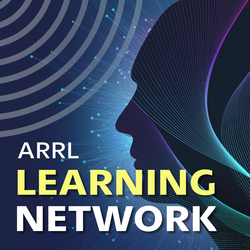 forums and radio club presentations, the webinars are intended to help participants get more active, involved, and engaged in amateur radio.
forums and radio club presentations, the webinars are intended to help participants get more active, involved, and engaged in amateur radio.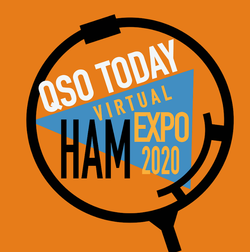 universities. The platform simulates a convention experience with an exhibit hall and booths staffed by live attendants, a speaker auditorium, and even a lobby. Attendance just requires an internet connection and a computer, tablet, or smartphone.
universities. The platform simulates a convention experience with an exhibit hall and booths staffed by live attendants, a speaker auditorium, and even a lobby. Attendance just requires an internet connection and a computer, tablet, or smartphone. 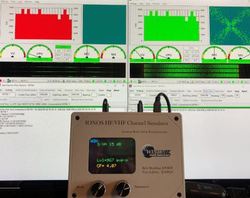 done with over-the-air testing where conditions are always changing," Whiteside said in the study's overview. "These simulators have been quite expensive in the past, typically costing thousands of dollars. With today's single-chip micros and DSP libraries, Rick and Tom were able to create this simulator with a total parts cost of less than $200."
done with over-the-air testing where conditions are always changing," Whiteside said in the study's overview. "These simulators have been quite expensive in the past, typically costing thousands of dollars. With today's single-chip micros and DSP libraries, Rick and Tom were able to create this simulator with a total parts cost of less than $200."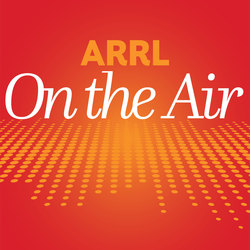 The latest episode of the On the Air podcast (Episode 7) features tips for soldering a PL-259 connector onto the end of a coaxial cable, and information on beginner courses for hams who want to serve their communities during disasters and other incidents. The On the Air podcast is a monthly companion to On the Air magazine, ARRL's magazine for beginner-to-intermediate ham radio operators.
The latest episode of the On the Air podcast (Episode 7) features tips for soldering a PL-259 connector onto the end of a coaxial cable, and information on beginner courses for hams who want to serve their communities during disasters and other incidents. The On the Air podcast is a monthly companion to On the Air magazine, ARRL's magazine for beginner-to-intermediate ham radio operators.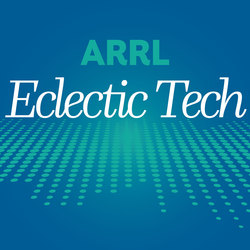 The latest episode of the Eclectic Tech podcast (Episode 12) features a discussion with Bob Allison, WB1GCM, about Low-Frequency activities, plus an update on the status of NextGen TV.
The latest episode of the Eclectic Tech podcast (Episode 12) features a discussion with Bob Allison, WB1GCM, about Low-Frequency activities, plus an update on the status of NextGen TV. Board. "It is up and transmitting WSPR on 20 meters using the call sign KQ6RS, and is being received all over the US and into Canada and Brazil." Karn is
Board. "It is up and transmitting WSPR on 20 meters using the call sign KQ6RS, and is being received all over the US and into Canada and Brazil." Karn is 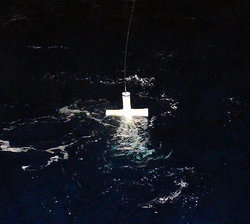 Cross arms were at the water line to add drag in the vertical direction, to counter the issue. Because sea water was required to tune the antenna, Standke floated the buoy off a dock in Mission Bay.
Cross arms were at the water line to add drag in the vertical direction, to counter the issue. Because sea water was required to tune the antenna, Standke floated the buoy off a dock in Mission Bay.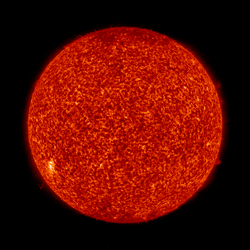 This sunspot cycle minimum remains surprisingly inactive. I keep expecting it to perk up, but all indicators remain quiet.
This sunspot cycle minimum remains surprisingly inactive. I keep expecting it to perk up, but all indicators remain quiet.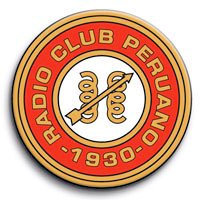 miles from the continent, so the pilot tuned to the Peruvian Relief Net on 7100 kHz.
miles from the continent, so the pilot tuned to the Peruvian Relief Net on 7100 kHz.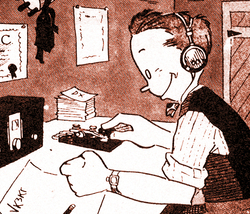 ARRL Field Day
ARRL Field Day .JPG) father for being his guide into amateur radio, recalling watching and listening to his dad operating mobile.
father for being his guide into amateur radio, recalling watching and listening to his dad operating mobile..jpg) A July 9 Nature Communications
A July 9 Nature Communications 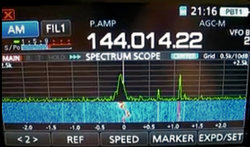 The Deutscher Amateur Radio Club (DARC) reported unauthorized transmissions in the 144 MHz satellite segment of the 2-meter amateur radio primary allocation. DARC said that signals from illegal transmitters in the 144.010 to 144.020 MHz range are coming from "water vitalizers" or "water energizers." The manufacturer specifies 144.015 MHz as the transmit frequency in its product description. The DARC Electromagnetic Compatibility (EMC) Department seeks further details and location information in preparation to file a complaint. "The devices apparently generate fields with considerable field strength and a long range," DARC said. "The signals appear increasingly in the morning or in the evening. The illegal transmitters are typically in operation from 5 to 60 minutes (in multiples of 5 minutes). The signal is generally very stable in frequency, but occasionally shows short-term fluctuations of up to a few hundred hertz." The carrier is not modulated. The 144.000 - 146.000 MHz band is allocated globally to the Amateur Radio and Amateur Satellite Services on a primary basis, and is the only globally harmonized amateur radio VHF band. DARC has posted a
The Deutscher Amateur Radio Club (DARC) reported unauthorized transmissions in the 144 MHz satellite segment of the 2-meter amateur radio primary allocation. DARC said that signals from illegal transmitters in the 144.010 to 144.020 MHz range are coming from "water vitalizers" or "water energizers." The manufacturer specifies 144.015 MHz as the transmit frequency in its product description. The DARC Electromagnetic Compatibility (EMC) Department seeks further details and location information in preparation to file a complaint. "The devices apparently generate fields with considerable field strength and a long range," DARC said. "The signals appear increasingly in the morning or in the evening. The illegal transmitters are typically in operation from 5 to 60 minutes (in multiples of 5 minutes). The signal is generally very stable in frequency, but occasionally shows short-term fluctuations of up to a few hundred hertz." The carrier is not modulated. The 144.000 - 146.000 MHz band is allocated globally to the Amateur Radio and Amateur Satellite Services on a primary basis, and is the only globally harmonized amateur radio VHF band. DARC has posted a .jpg) An EME SSTV Party could become an annual event. Many stations are reported to have made Earth-moon-Earth (EME) SSTV transmissions on last year's 50th anniversary celebration of the moon landing. "We could only do it on the exact date 50 years later, and EME conditions were not very good last year," said Jan van Muijlwijk, PA3FXB, of the PI9CAM team at Dwingeloo Astronomic Observatory. "[W]e saw many stations joining the SSTV party, and we were surprised to see what is possible even with small dishes. Because of that, we would like to try to make it an annual EME SSTV party." A lunar landing EME SSTV party is set for July 26. "Moon conditions will be better than last year," van Muijlwijk said. "The moon is not very high in the northern hemisphere but much closer than last year, so we expect stronger signals and better images. The PI9CAM team will transmit several lunar landing and space-related images on 1296.110 MHz using Martin 2 mode.
An EME SSTV Party could become an annual event. Many stations are reported to have made Earth-moon-Earth (EME) SSTV transmissions on last year's 50th anniversary celebration of the moon landing. "We could only do it on the exact date 50 years later, and EME conditions were not very good last year," said Jan van Muijlwijk, PA3FXB, of the PI9CAM team at Dwingeloo Astronomic Observatory. "[W]e saw many stations joining the SSTV party, and we were surprised to see what is possible even with small dishes. Because of that, we would like to try to make it an annual EME SSTV party." A lunar landing EME SSTV party is set for July 26. "Moon conditions will be better than last year," van Muijlwijk said. "The moon is not very high in the northern hemisphere but much closer than last year, so we expect stronger signals and better images. The PI9CAM team will transmit several lunar landing and space-related images on 1296.110 MHz using Martin 2 mode.







